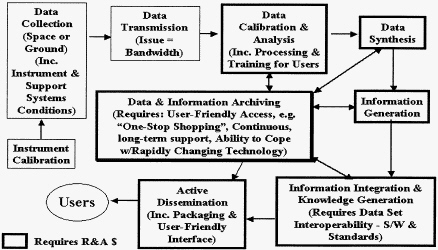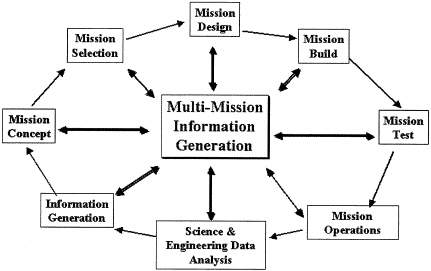Appendix B
The Data Life Cycle
Data and information considerations play a critical role in all parts of the development of a space or earth science mission (see Figure B.1).
-
Mission planning includes attention to data management as part of the overall project strategy. Science goals provide the basis for defining the requirements for data content, quality, and level of analysis, and these requirements must be factored in to the design of the project. During this planning phase, policies are established concerning the format of the data, data rights, and where and how the data will be processed, delivered, and archived.
Many missions are part of a larger program (e.g., Earth Observing System, Mars Exploration Program), and the availability of information from one mission in a series is often needed to support the design of subsequent missions. Indeed, the formulation of mission concepts is usually based on the results of previous missions. For example, the recently launched Microwave Anisotropy Probe mission was conceived in response to the results of the Cosmic Background Explorer mission. Thus, designers of new mission concepts must have access to well-formulated and complete information. In the case of some programs, such as the Mars Exploration Program, the time frame for conception of new missions is very short since launch opportunities exist at frequent intervals (every 26 months in the case of the Mars program). Other missions have a finite lifetime, and so early observations are important in guiding subsequent experiments. The Space Infrared Telescope Facility has planned a Legacy Program, which will make reduced observations from the earliest phases of operation available to the community so that it can optimize the use of the limited observing time available with this telescope. In such cases, adequate funding must be provided for timely research and analysis in order to generate the needed planning and management information.
-
Mission selection involves many users of information, including managers at NASA Headquarters for program and project formulation and budgeting, and officials in the executive and legislative branches for program and project funding.
-
Mission and project design and building depend on information such as spacecraft and instrument performance, whereas mission testing depends on information about the operational environment that has been obtained from other missions.
-
Mission operations must be considered in all aspects of mission design, because the investment in operational infrastructure (e.g., Tracking and Data Relay Satellite System and Deep Space Network resource requirements and time allocation), plus the associated data and information infrastructure to support operations require a considerable fraction of the resources
-
of any space mission. Trade-offs are needed, for instance, between preliminary processing of data onboard a spacecraft and processing on the ground.
-
Analysis of science data from a mission must be supported by information on factors such as the state of the spacecraft at the time the data were gathered. Data from one instrument can shed light on the state of another instrument; for example, a weather sensor on a Mars lander can provide temperature information for the calibration of a camera.
-
Finally, the conversion of data into information is the “value added” process that creates the products of the mission—knowledge about the Earth, the planets, and the cosmos.
Figure B.2 illustrates the elements of the information flow from a space mission or collection of missions that must be designed and supported. Data collected both from space and ground facilities must often be integrated. For example, remotely sensed data from earth observing satellites must be validated with “ground truth” data. Both space (e.g., the Hubble Space Telescope) and ground (e.g., the Keck telescope) astronomical observations can shed light on astrophysical processes.
Viking Mars data collected in the late 1970s are still being used to provide context and augment modern Mars observations from the Mars Global Surveyor. This example illustrates the necessity of secure, long-term data and information archiving with user-friendly access. Long-term maintenance of data, in turn, requires the ability to cope with rapidly changing technology. NASA and other agencies still have older data stored, precariously, on paper and computer tape, whereas new data are stored on CDs and on silicon media. Coping with these diverse forms and formats poses a challenge to users.
Data collection, whether in space or on Earth, requires ancillary data in addition to the data from the science instruments themselves. Such metadata includes information on where an instrument was pointed, the instrument’s temperature, its state of power, and so on. Transmission of the data and metadata, particularly from deep space missions, is often a bottleneck because of the increasing power and antenna aperture required as spacecraft fly farther from the Earth.
Data captured by a ground station must be calibrated and analyzed merely to account for the idiosyncrasies of the instrument in its environment. Sometimes this calibration can be very time consuming and expensive, particularly when an instrument is flying in an unknown environment. In the case of recent Mars missions, for example, the presence of atmospheric dust confused interpretation of thermal readings from the surface. Similarly, clouds on Earth present problems for satelliteborne instruments attempting to acquire surface measurements in the visible and infrared spectrums. Some of the complexities in developing data pipelines result from the need to use high-level data products from one instrument (e.g., high-resolution cloud masks) as input to processing of data from other instruments so that the observations can be interpreted properly.
In order to draw scientific conclusions about the state of an observed planet, astronomical object, or region on Earth, data from a number of instruments must often be synthesized. For example, imaging and laser altimetry data from the Mars Global Surveyor have been combined to draw conclusions about the possibility of liquid water on the surface of the planet.1 The process of synthesizing data generates information, which is then interpreted to produce knowledge. For example, the determination of whether humans are contributing to global warming of the Earth requires considerable synthesis of data collected from a wide variety of

FIGURE B.2 The flow of data from initial acquisition to end users. This diagram illustrates the various steps in processing and disseminating data and some of the areas where significant investment is required in order to realize the full scientific potential of missions (e.g., for calibration, bandwidth, interoperability of various active archives and mission sites, user-friendly interfaces, and so on).
platforms (satellite, aircraft, ship, ground) over many years.2 For the synthesis to occur data sets must be in a form in which they can be integrated—at a minimum they must use the same quantities! Standard software and community-accepted standards for data analysis are essential. Data that are archived must also be saved in standard forms so that they can be stored, retrieved, and used efficiently.
Finally, information must be widely disseminated to users to ensure a proper return on the investment of the time and cost of collection. Users include not only the scientists who generate knowledge from the data, but a very large nonscientist community, including engineers who design and implement future missions; managers who make decisions about mission design, selection, and funding; decision makers such as Congress, and the general public. The public includes students, educators, the news media, commercial enterprises, and interested people worldwide.
Table B.1 summarizes the categories of users who need information at different stages of the space mission process shown in Figure B.1. Engineers and scientists are actively involved in all stages, whereas managers are usually making decisions only in the “project” portions of a mission. Congress and the budgetary and policy elements of an administration are involved primarily in the selection process. The public is the ultimate consumer of space-derived knowledge, but it is also a participant in information generation (e.g., the news media and educators), in influencing mission conceptualization and selection, and even, in rare instances, in mission operations (e.g., student selection of targets for the Mars Orbiting Camera).
TABLE B.1 Information Users in the Stages of a Space Mission
|
Stage |
Engineers |
Managers |
Congress |
Scientists |
Public |
|
Mission concept |
X |
X |
X |
X |
|
|
Mission selection |
X |
X |
X |
X |
X |
|
Mission design |
X |
X |
X |
||
|
Mission building |
X |
X |
X |
||
|
Mission testing |
X |
X |
X |
||
|
Mission operations |
X |
X |
X |
||
|
Science and engineering data analysis |
X |
X |
|||
|
Information generation |
X |
X |
X |
X |
|
|
Multi-mission information generation |
X |
X |
X |
X |
|






